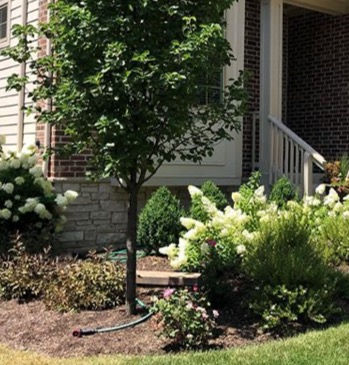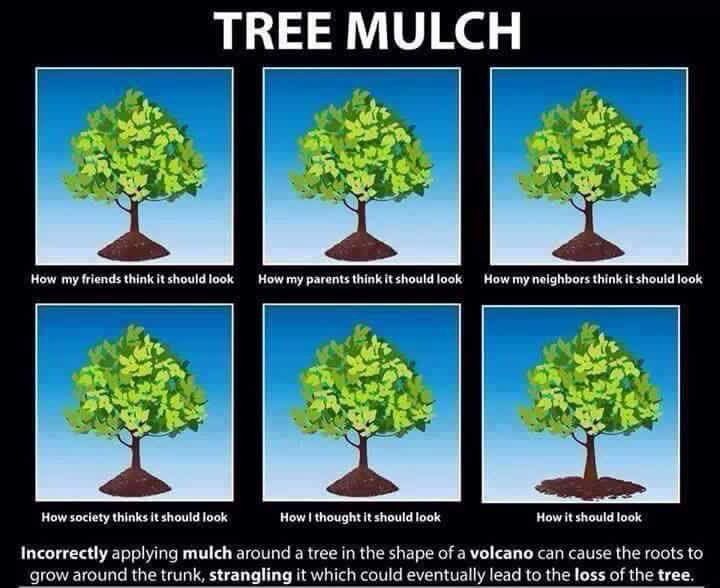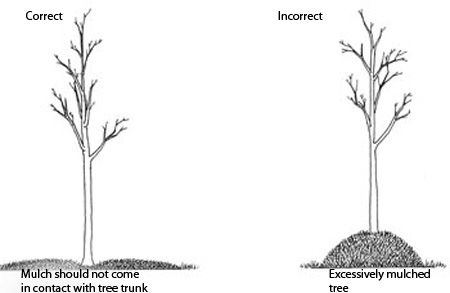Love your trees with mulch
- Melissa Wickert
- Jun 26, 2020
- 2 min read
Updated: Jun 27, 2020
Mulch is both functional and decorative.
But did you know that you can help or hurt your trees with how you use mulch?

Our installation team knows the ins and outs of mulching. Aesthetically, often we hear that mulching around a tree should look “built up” so more mulch can be seen. Homeowners often think the “built up” look makes the landscape look more polished.
To explain further, we love this diagram. It explains this trend well:

Often our job includes fixing mulch to improve the health of trees, shrubs and plants. Below is a primer on how mulch should be applied, and the benefits and issues related to mulch. *
How mulch should be applied
Mulch under trees, shrubs, and throughout planting beds is recommended to be spread at depth of 3-4 inches (for medium to coarse textured materials.
Our team will pull mulch away from the bases of tree and shrub trunks creating a donut-hole (image on left.) We do not pile mulch up against the trunk (“volcano mulching”). Excessive mulch on the trunk causes moisture to build up, creating ideal conditions for insect pests, diseases, and decay (image on right.)
Ideally, the mulched area around a tree should extend to the drip line of the branches, or at least cover a 4-5-foot diameter area around the trunk. The larger the mulched area, the more beneficial.
Correct mulching on left, incorrect mulching on right

Seasonally, when mulch is spread also matters, because you don’t want to inflict temperature damage on the tree/plant. When applying mulch as winter protection, it’s best to avoid applying it too early in the fall, since mulch can delay the soil freezing process by retaining heat in the soil. If applied too early in the spring, mulch can delay root growth. As a general rule, we wait until after a hard frost in the fall to apply winter mulch, and after the last frost in spring to apply summer mulch.
What are the benefits of mulch?
There are many benefits to the proper use of mulch, including:
Provides an insulation layer from temperature extremes
Conserves/balances soil moisture
Improves the soils structure and fertility
Prevents water erosion and runoff
Reduces root competition
Protection from lawnmower damage
Recycles landscape waste
Provides a more natural appearance of the landscape
Provides a favorable environment for living organisms
What are the problems created by incorrect use of mulch?
Too much mulch can be harmful because:
It creates too much of a barrier for the tree or plant to receive oxygen and water
It can create excessive moisture
It can cause heat injury to the tree/plant
It can cause root collar rot by causing decay to the base of the tree/plant
It can create weeds if you use an organic mulch that has not been treated for weed seed prevention
Ask for a free consultation!
As part of our free consultation, we will evaluate your existing landscape and make recommendations for the health of your trees, shrubs and plants. Contact us today to learn more.
*Written with input from Morton Arboretum, source including https://www.mortonarb.org/trees-plants/tree-and-plant-advice/horticulture-care/mulching-trees-and-shrubs






Choosing the right yoga mat might seem like a simple decision, but for anyone who practices yoga regularly, it can make a world of difference. A yoga mat is not just an accessory—it’s the foundation of your practice.
We do a lot of tree removal in Bremerton and always tell people to be cautious with mulch. Your tree roots need to be exposed and you should do it just right.